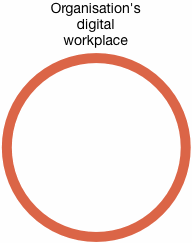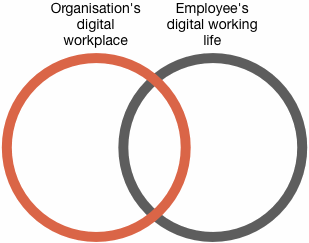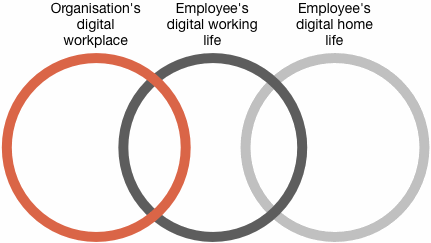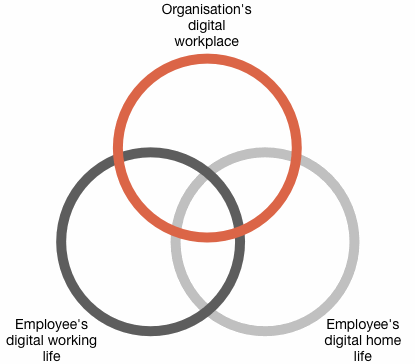What’s the employee’s view of the digital workplace?
In my last post we started hovering just behind the ear of one of your colleagues, as they did their work in different places, in different ways, with different tools. Let’s keep him in mind, for his view of the digital workplace is very different from your view as a “digital workplace manager”. In this post I’m going to put the organization’s digital workplace into context with an employee’s other digital lives – both professional and personal.
We’ve defined the organization’s digital workplace so [drum roll]:
Definition:
“The digital workplace is the collection of all of the digital tools provided by an organisation to allow its employees to do their jobs.”
This definition is unashamedly organization-centric. Organizations have digital workplaces; they pay for them and they pay for people to look after them and worry about whether the tools are secure, useful and usable. I’m going to represent that boundary as an orange circle:

For DWG to be useful to those it serves, this is where we stand. But it can’t and doesn’t stop there.
What about the workers?
But an organization’s digital workplace is only a small slice of someone’s daily digital life. There are loads of digital tools that people need “to do their jobs” that are not provided by the organization. Things like Twitter are pretty important to a PR person. Documentation and reference information is on the web for hundreds of different roles. Imagine your peer networks on LinkedIn and other platforms, or all the “interfaces” of suppliers, partners, vendors and financial or regulatory institutions.
There is another view here though – there is a massive chunk of your systems, content and tools that an individual employee doesn’t use. Let’s go Venn:

There is actually only a slight crossover between all the digital tools that are organizationally provided and those that employees actually use directly. The average employee only interacts with a small portion of an organization’s digital environment. But we aren’t done yet. Let’s not forget that each of our colleagues has a life:

There is now a bleed between an employee’s digital working life and their home life. Some things are clearly “at home” like Facebook, watching Doctor Who on BBC iPlayer and internet dating. Some things are even more blurred, like running Citrix on a home PC or checking company Webmail. Oh hang on, those are also part of the organization’s digital workplace. It’s all more intertwingled than that.
Let’s Venn-up a level:

That’s better but whoa Einstein! There are seven different cases. Let’s unpack this in more detail and try and make sense of it all from the perspective of the employee:

Case I – The organization’s digital workplace they don’t use
They don’t use everything, they only use a part of what you’ve got. They don’t care about what they do not use and it only becomes relevant when it is required.
What you need to do about it: Abstract it, hide it, obscure it. They don’t care about the 1,500 intranet applications they don’t use. Don’t necessarily keep it under lock and key, particularly if it might be conceivably useful, but prioritize what they do use and what is most useful. Make it their digital “room of requirement” – it’ll be there when they need it.
Cases II and III – The organization’s digital workplace they do use – at work (II) and at home (III)
What they use, they care about. If it doesn’t work, they will find a workaround. Case II is the classic use of IT systems for work purposes. Case III intersects with the employee’s digital home life. This is where it is all going on at the moment. The organization is now a guest in their homes. Please remember your Ps and Qs and leave your muddy shoes at the door. This is often your stuff on their kit. BYOD and all its many (sigh) variants; Citrix on home PCs and Macs; Webmail; or at least using their home Internet connection. Those relying on their own internet to complete their work may want to have an in-depth understanding of their router so they know what to do if something goes wrong or they can’t connect; Anyway, back to what I was saying… The list goes on.
What you need to do about it:
For case II: Optimize it. Make it as good as you can with the resources and technology that is at your disposal. A user-centred design approach will help you make this stuff truly good for employees to use. Make sure you provide a secure online platform for them to work with. This will give them reassurance that their work or personal information will be secure.
For case III: Optimize with gentle control. The employee is doing you a favour here. You, digital workplace manager, are using their hardware to extend your organization’s capabilities. You need to make it user-friendly enough to be adopted, but you also need to ensure that the organization, its data and its regulatory obligations are not put at risk. If that risk can’t be mitigated, you’ll need to spend the money to provide the hardware directly, and be clear to your employees why BYOD and its brethren aren’t allowed. (I investigated this topic for DWG a while back: part 1 and part 2.)
Case IV – The employee’s reasonable and unreasonable personal use of the organization’s digital workplace
From sending personal email through to looking at dodgy websites, this stuff still happens. People are a lot more savvy these days, and they have their personal digital life in their pocket.
What you need to do about it: Be clear through the use of well communicated policy about what is and isn’t OK.
Case V – The employee’s digital workplace you didn’t provide
The danger zone. The stuff you don’t have direct control over. This is full of blurred lines as there is an entire range of the internet to worry about and you don’t know what every single person might need to reasonably achieve their role. Here we set guidelines and, in general, this has been an uncontentious area. You need to look up documentation about programming languages? Go ahead. You need to book a train ticket? Knock yourself out. You need to upload all of your project documentation onto Dropbox? Hold your horses there fella.
From the employee’s point of view there is an all-you-can-eat-buffet of services that they can conceivably use to fulfil their role. You need to assume that unless you provide a good service, they’ll find away around you here.
What you need to do about it: Control with a firm policy communicated well to adults whom you trust to behave responsibly. You need to be very clear about what is and is not acceptable, both in terms of the technology they are allowed to unilaterally deploy, as well as the expected norms of personal behaviour.
Case VI – Personal accounts and tools for work purposes
Need to log in to something using Google? Or Facebook? Or Twitter? Need to make the occasional phone call for work purposes using a personal line? Printing work stuff at home? Another messy blurry area from the reality of what people actually need to do to get things done.
What you need to do about it: Be aware of what some of these cases might be. There might be risks here you need to manage and that could actually be useful opportunities to take advantage of.
Case VII – Their digital home life unconnected with work
After all work comes rest and play – the two things we do the work for in the first place. There may be concerns that an employee’s digital home life, might compromise the organization in some way, but in general: relax.
What you need to do about it: Ignore it. Let them sleep, and leave the social media monitoring to the NSA. If it’s important that someone’s behaviour in their personal life doesn’t compromise their role, this needs to be made clear to them.
It’s only a model
I’m well aware that digital workplaces aren’t in fact orange circles – these categories may or may not hit the mark. We humans love to make categories and as I’ve spent too long practising information architecture, I am conditioned to do so. But to push further into this topic we need to map the landscape. The world of work changed, and we didn’t really notice. Your users-your colleagues-don’t have a narrative for all of these weird cases; they bumble on as best as they can.
But you don’t. So what can you do to hand them a map?
Related research: Digital workplace user experience
Digital workplace user experience – designing for a flexible workforce
 The digital ecosystem of applications and systems provided to employees have usually been built-up piecemeal for a desk-bound user population. The report suggests that organizations can tackle issues such as loss of productivity and reduced adoption of critical services by looking at the digital workplace through the lens of the user experience.
The digital ecosystem of applications and systems provided to employees have usually been built-up piecemeal for a desk-bound user population. The report suggests that organizations can tackle issues such as loss of productivity and reduced adoption of critical services by looking at the digital workplace through the lens of the user experience.
Categorised in: Uncategorized
